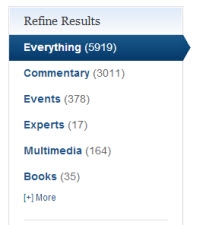Search vs. Browse: Website Navigation’s Heavyweight Title Match

In order for any website to be truly effective it needs to meet one overarching goal – it should be easy for users to engage with the site and find the content they are looking for. Unless you are working with a small microsite or a very basic blog, the primary way to accomplish this is through thoughtful site navigation. While everyone naturally wants to have an effective website, there are many challenges to overcome when building out your website navigation.
Some of these include:
- Structuring your website based on internal business units without understanding how your users think
- Generalizing about how users will want to narrow in on their intended content
- Confusing your users with how you’ve chosen to group content
The two primary navigation methods, search and browse, both have their place in the modern web. Although browsing is arguably still the dominant way to consume content on most websites, as a site becomes larger it can be become quite difficult to solve user pathway challenges with structured navigation. Additionally, users are becoming increasingly comfortable with using a search interface to discover new content as they grow accustomed to navigating large and extremely complex sites on a regular basis.
Measure Twice, Cut Once
Before embarking on a website redesign or making adjustments to your navigation, the best source of how to proceed is your existing data. A great place to look for data is in your web analytics package. If you have seasonal spikes, be sure to pick an appropriate length of time to review. If you have a large spike for an annual conference, perhaps look back a year or two. Review the most common paths that users are taking on your site, and figure out what content is most relevant to your users and what you might be able to remove or simplify. Less is more in many cases.
Tip: Be sure to redirect aged out pages to current parts of your website. This is particularly useful if the pages had good traffic in the past, but are no longer relevant.
Once you identify and remove unnecessary content, consider the metadata for your remaining content. This is a topic that deserves its own post, but essentially you should examine the thoroughness of your metadata and how it is organized. Do you have good batches of structured content?
- Examples of possible metadata include: Authors, Articles, Press Releases, Products, Product Types, Dates, Events and any other specific taxonomy related to your lines of business.
Now that you understand what content is essential to keep, and how much structure exists, you should ask yourself the following questions:
- Do you have the right metadata to support an effective search solution?
- Does the quality of the metadata meet your expectations?
- If not, would it be possible for your team to enrich this data?
If you answered yes to both of those questions, you might be a good candidate for a robust search solution. In either case, it is helpful to think about how each method of navigation works and how it would tie in to your content and business goals.
Which One is Right for Me?
Browse
Browse is the primary navigation system on most sites. It is usually revealed with drop-down menus at the top of the page and often navigation on the left-hand side of content pages. Depending on your site’s depth of content, additional navigation can be seen typically in the center column above the content itself, or at the top of the right rail. As you can imagine, deep websites can easily drown the content with heavy navigation all over the site.

A simple navigation menu, from Velir.com
When building your browse-based navigation, consider these tips:
- Put yourself in the user’s position. Orient your navigation so that users are not beholden to internal business units unless there is a very strong identification across your user base with these classifications.
- Reveal deeper navigational options as the user explores. Users tend to be overwhelmed when presented with too many options too early.
- Stick with established patterns for key activities. Primary navigation belongs near the top of the page. Utility navigation for user log in or search belong in the upper right corner. These patterns have emerged over a very long time. You should deviate patterns only after a thorough evaluation of your audience and their sophistication.
- Over the last few years, “thick” footers have emerged as a sort of table of contents for your site. While this is handy, you should balance the heft of any footer against the rest of the site. Your footer shouldn’t be taller than the rest of the site.
Search
Search navigation is very familiar to those that shop online. Sites like Zappos use search to enable users to explore the website’s rich product offerings. While Zappos also provides a browse model, they are really creating their browse experience using the power of search. This ability for users to pick their entry point to the site is very powerful. Users can find the same products through a seemingly endless combination of options. Each category of structured content is an opportunity to introduce faceted search to your site, allowing you to narrow results by certain characteristics.
When building your search-powered navigation, consider these tips:
- You can easily leverage search to power list pages and related content features
- All facets are not created equal. Prioritize your filters so that the highest value facets are presented first.
- Be sure to spend time tuning the ranking priorities for your content to surface the most relevant content at the top of your search results.
Tip: If your site exists among a family of closely linked sites, consider federated search, as well. Federation is a fancy way to say, the search tool will also search these other websites for content. If your sites are a community of related sites, this may enhance the findability of content across your web ecosystem. Search platforms like Coveo can be a great way to integrate faceting and federation into your website along with powerful insight metrics that can help you to continually refine your search parameters.

An example of faceting, from brookings.edu
Summary
While one approach will never be appropriate for all websites, more organizations are adding search-based navigation to their website. By looking objectively at your traffic, analyzing the richness of your metadata and working to understand your users, your site can encourage engagement from everyone who visits it. Not only will your users get more value from your website, but you can be sure that every piece of content you create is accessible and easy to discover.



